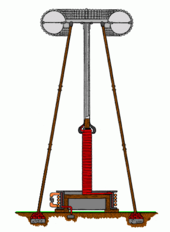Wardenclyffe years (1900–1917)
Main article: Wardenclyffe Tower
In 1900, with $150,000 ($4,252,200 in today's dollars[58]; 51% from J. Pierpont Morgan), Tesla began planning the Wardenclyffe Tower facility.[122]
Tesla later approached Morgan to ask for more funds to build a more powerful transmitter. When asked where all the money had gone, Tesla responded by saying that he was affected by the Panic of 1901, which he (Morgan) had caused. Morgan was shocked by the reminder of his part in the stock market crash and by Tesla's breach of contract by asking for more funds. Tesla wrote another plea to Morgan, but it was also fruitless. Morgan still owed Tesla money on the original agreement, and Tesla had been facing foreclosure even before construction of the tower began.[117]
In December 1901, Marconi successfully transmitted the letter S from England to Newfoundland, terminating Tesla's relationship with Morgan.[improper synthesis?] Over the next five years, Tesla wrote over 50 letters to Morgan, pleading for and demanding additional funding to complete the construction of Wardenclyffe. Tesla continued the project for another nine months. The tower was erected to its full 187 feet (57 m).[117] In July 1903, Tesla wrote to Morgan that in addition to wireless communication, Wardenclyffe would be capable of wireless transmission of electric power.[122] On 14 October 1904, Morgan finally replied through his secretary, stating, "It will be impossible for [me] to do anything in the matter," after Tesla had written to Morgan when the financier was meeting with the Archbishop of Canterbury in an attempt to appeal to his Christian spirit.[117]
In June 1902, Tesla's lab operations were moved to Wardenclyffe from Houston Street.[122]
On his 50th birthday in 1906, Tesla demonstrated his 200 horsepower (150 kilowatts) 16,000 rpm bladeless turbine. During 1910–1911 at theWaterside Power Station in New York, several of his bladeless turbine engines were tested at 100–5,000 hp.[123]
Tesla invented a steam-powered mechanical oscillator—Tesla's oscillator. While experimenting with mechanical oscillators at his Houston Street lab, Tesla allegedly generated a resonance of several buildings. As the speed grew, it is said that the machine oscillated at the resonance frequency of his own building and, belatedly realizing the danger, he was forced to use a sledge hammer to terminate the experiment, just as the police arrived.[16]:162–164 In February 1912, an article—"Nikola Tesla, Dreamer" by Allan L. Benson—was published in World Today, in which an artist's illustration appears showing the entire earth cracking in half with the caption, "Tesla claims that in a few weeks he could set the earth's crust into such a state of vibration that it would rise and fall hundreds of feet and practically destroy civilization. A continuation of this process would, he says, eventually split the earth in two."[91]
Tesla theorized that the application of electricity to the brain enhanced intelligence. In 1912, he crafted "a plan to make dull students bright by saturating them unconsciously with electricity," wiring the walls of a schoolroom and, "saturating [the schoolroom] with infinitesimal electric waves vibrating at high frequency. The whole room will thus, Mr. Tesla claims, be converted into a health-giving and stimulating electromagnetic field or 'bath.'"[124] The plan was, at least provisionally approved by then superintendent of New York City schools, William H. Maxwell.[124]
Before World War I, Tesla sought overseas investors. After the war started, Tesla lost the funding he was receiving from his patents in European countries. Eventually, he sold Wardenclyffe for $20,000 ($470,900 in today's dollars[58]).[122] In 1917, around the time that the Wardenclyffe Tower was demolished by Boldt to make the land a more viable real estate asset, Tesla received AIEE's highest honor, the Edison Medal.[125]
In the August 1917 edition of the magazine Electrical Experimenter Tesla postulated that electricity could be used to locate submarines via using the reflection of an "electric ray" of "tremendous frequency," with the signal being viewed on a fluorescent screen (a system that has been noted to have a superficial resemblance to modern radar).[126] Tesla was incorrect in his assumption that high frequency radio waves would penetrate water[127] but Émile Girardeau, who helped develop France's first radar system in the 1930s, noted in 1953 that Tesla's general speculation that a very strong high frequency signal would be needed was correct stating "(Tesla) was prophesying or dreaming, since he had at his disposal no means of carrying them out, but one must add that if he was dreaming, at least he was dreaming correctly."[10]:266[128]
Nobel Prize rumors
On 6 November 1915, a Reuters news agency report from London had the 1915 Nobel Prize in Physics awarded to Thomas Edison and Nikola Tesla; however, on 15 November, a Reuters story from Stockholm stated the prize that year was being awarded to Sir William Henry Bragg and William Lawrence Bragg "for their services in the analysis of crystal structure by means of X-rays."[10]:245[129][130] There were unsubstantiated rumors at the time that Tesla and/or Edison had refused the prize.[10]:245 The Nobel Foundation said, "Any rumor that a person has not been given a Nobel Prize because he has made known his intention to refuse the reward is ridiculous"; a recipient could only decline a Nobel Prize after he is announced a winner.[10]:245
There have been subsequent claims by Tesla biographers that Edison and Tesla were the original recipients and that neither was given the award because of their animosity toward each other; that each sought to minimize the other's achievements and right to win the award; that both refused ever to accept the award if the other received it first; that both rejected any possibility of sharing it; and even that a wealthy Edison refused it to keep Tesla from getting the $20,000 prize money.[10]:245[22][131]
In the years after these rumors, neither Tesla nor Edison won the prize (although Edison did receive one of 38 possible bids in 1915 and Tesla did receive one of 38 possible bids in 1937).[132]




No comments:
Post a Comment